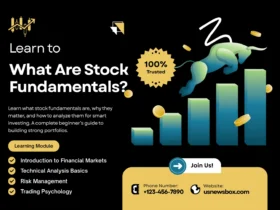Investing in the stock market has always been one of the most powerful ways to grow wealth, beat inflation, and build financial independence.
But the investment landscape is constantly changing. As we move into 2025 and beyond, technology, new regulations, and global economic shifts are reshaping how people invest.
Whether you’re a complete beginner or someone looking to upgrade your investment strategy, this comprehensive guide will help you start investing in stocks with confidence.
📈 1. Why Invest in Stocks in 2025?
The stock market has historically offered higher returns than traditional saving options like fixed deposits or savings accounts. But in 2025, the opportunities are even more exciting:
- Technological transformation: Companies in AI, renewable energy, and digital infrastructure are expected to see exponential growth.
- Global access: With digital brokerages, you can invest in companies listed on New York Stock Exchange or National Stock Exchange of India from your smartphone.
- Increased financial literacy: More educational content and investor-friendly platforms are empowering individuals to take charge of their financial future.
- Rising inflation: Stocks help protect your wealth against inflation over the long term.
💡 In short: Investing in stocks is no longer just for the wealthy — it’s for anyone who wants to build long-term financial security.
🧭 2. Understanding How Stocks Work
Before jumping in, it’s crucial to understand what stocks are.
- A stock represents ownership in a company.
- When you buy shares of Apple Inc., for example, you own a small part of the company.
- As the company grows and profits, the value of your shares may increase.
- Some companies also pay dividends — a share of their profits — to investors.
📊 Key Terms to Know:
- Stock Exchange: Platforms where stocks are traded (e.g., Bombay Stock Exchange, NASDAQ).
- Broker: A company or platform that enables you to buy and sell stocks.
- IPO (Initial Public Offering): When a company lists its shares on the stock market for the first time.
- Market Cap: The total value of a company’s outstanding shares.
- Bull & Bear Market: Bull = rising market; Bear = falling market.
🧾 3. Step-by-Step: How to Start Investing in Stocks in 2025-26
Step 1: Set Clear Financial Goals
Ask yourself:
- Do you want to invest for the short term or long term?
- Are you aiming for wealth creation, passive income, or retirement savings?
Having a goal-based investment plan keeps your strategy focused.
Step 2: Build an Emergency Fund
Before investing, make sure you have 3-6 months of expenses saved. This prevents you from pulling out your investments during market dips.
Step 3: Choose the Right Stockbroker
Look for:
- Low brokerage fees
- Easy-to-use trading app
- Strong security features
- Access to domestic and international markets
Examples include Zerodha, Groww, and Interactive Brokers.
Step 4: Complete KYC and Open a Demat Account
To invest in stocks in India, you’ll need a Demat and trading account. Most brokers offer paperless account opening within minutes.
Step 5: Learn to Analyze Stocks
- Study company fundamentals: revenue, profit, debt, cash flow.
- Understand industry trends.
- Evaluate the valuation of the company (P/E ratio, book value, etc.).
Step 6: Start Small
You don’t need lakhs to invest. Start with as little as ₹500–₹1000, and scale gradually as you gain confidence.
Step 7: Diversify Your Portfolio
- Don’t put all your money in one stock.
- Spread investments across different sectors and industries.
- Consider adding ETFs and mutual funds for balanced risk.
Step 8: Automate Your Investments
Use SIP (Systematic Investment Plan) or recurring investment features to invest consistently every month.
💡 4. Best Investment Strategies for 2025-2026
✅ Long-Term Investing
Buy fundamentally strong companies and hold them for 5–10 years. This helps ride out short-term volatility and build wealth over time.
📉 Value Investing
Look for undervalued stocks with strong fundamentals. This classic strategy made Warren Buffett one of the world’s wealthiest investors.
🚀 Growth Investing
Invest in companies with high growth potential — often in emerging sectors like AI, green energy, or healthcare innovation.
🪙 Dividend Investing
Invest in companies that regularly pay dividends to generate passive income.
🌍 Global Investing
Through international brokers or mutual funds, you can invest in companies listed in global markets like the US, Europe, or Asia.
🧮 5. Key Sectors to Watch in 2025 and Beyond
- Artificial Intelligence & Automation — companies leveraging AI technology.
- Green Energy — renewable power, EV infrastructure, and clean tech.
- Healthcare & Biotech — telemedicine, drug innovation, genetic research.
- Digital Finance (FinTech) — digital payments, blockchain solutions.
- Infrastructure & Real Estate — urban development and smart cities.
💰 Investing in future-oriented sectors can give early investors an edge.
📉 6. Common Mistakes to Avoid When Investing
- ❌ Chasing “hot tips” or rumors.
- ❌ Investing without research.
- ❌ Putting all your money in one stock.
- ❌ Emotional buying and panic selling.
- ❌ Ignoring diversification and risk management.
“The stock market is a device for transferring money from the impatient to the patient.” — Warren Buffett
🧠 7. How to Manage Risk
- Set stop-loss levels to protect against heavy losses.
- Diversify across different asset classes — stocks, bonds, ETFs.
- Keep some cash reserves to buy during market corrections.
- Invest only what you can afford to lose.
📲 8. Best Tools & Apps for Stock Investing in 2025
Here are some top investment platforms for beginners and experienced investors:
- Zerodha – Best for low brokerage.
- Groww – Simple interface for beginners.
- Upstox – Fast and easy trading platform.
- Interactive Brokers – Ideal for global investing.
- Yahoo Finance & TradingView – Great for stock research and charting.
🧮 9. Tax Implications of Investing in Stocks
In India:
- Short-Term Capital Gains Tax (STCG): 15% if sold within 1 year.
- Long-Term Capital Gains Tax (LTCG): 10% beyond ₹1 lakh after 1 year.
- Dividend Tax: Taxable as per your income slab.
Always consult a financial advisor or tax professional for personalized guidance.
📚 10. How to Keep Learning and Improving
Investing is a continuous learning process.
Some trusted resources to build your knowledge:
- The Intelligent Investor by Benjamin Graham
- One Up On Wall Street by Peter Lynch
- Rich Dad Poor Dad by Robert Kiyosaki
- Online courses and webinars from reliable investment platforms.
🏁 11. Building Wealth Beyond 2025: Final Thoughts
Investing in stocks is not about timing the market — it’s about time in the market. By starting early, staying consistent, and making informed decisions, you can build long-term wealth and achieve financial independence.
🌟 Key Takeaways:
- Start small, but start today.
- Focus on quality companies, not quick profits.
- Learn, adapt, and invest regularly.
- Think long term — your future self will thank you.
“Do not save what is left after spending, but spend what is left after saving.” — Warren Buffett
🪙 FAQs on Investing in Stocks (2025-2026)
Q1: Can I invest in stocks with just ₹500?
Yes. Many brokers allow fractional or small investments.
Q2: Is it safe to invest in the stock market?
There are risks, but with research and diversification, you can minimize them.
Q3: What’s the best stock to invest in 2025?
There’s no “best” stock. Instead, look for companies with solid fundamentals and growth potential.
Q4: Should I hire a financial advisor?
If you’re new and want personalized guidance, a registered financial advisor can help.
Q5: How long should I hold my stocks?
Ideally 3–5+ years for best compounding returns.
🧭 Final Words
2025-2026 is an excellent time to start investing in stocks. With the rise of technology, easy access to markets, and abundant learning resources, anyone can become a smart investor.
Start small, stay patient, and let the power of compounding build your financial future.
✅ Pro Tip: Consistency beats intensity. Even a small monthly investment can turn into a large portfolio in 10-15 years.












Leave a Reply